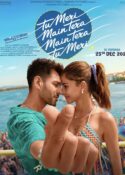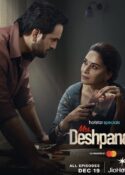 Indian cinema has evolved over the years in many aspects. Be it story line, characters or costumes. However, when one speaks on the topic of evolution of choreography and dance in the industry, many names come to mind on who has contributed to the evolution of dance on stage and the silver screen. Amongst these names rises the name of Terence Lewis, the choreographer who’s given a new outlook to Contemporary Dancing in the Hindi Film Industry. Having attained several prestigious opportunities and acclaim across the globe, the talented choreographer still calls India his base and continues his endeavor to promote a stronger emphasis on dance in Indian cinema. Recently, he became a house hold name as the ultra perfectionist when it came to dance through what many claim to be the best dance reality show in India, Dance India Dance. Post DID his fan following and admirers have grown in abundance so today we bring you an exclusive interview with your favourite dance master as he speaks about his past, his achievements and most importantly, dance!
Indian cinema has evolved over the years in many aspects. Be it story line, characters or costumes. However, when one speaks on the topic of evolution of choreography and dance in the industry, many names come to mind on who has contributed to the evolution of dance on stage and the silver screen. Amongst these names rises the name of Terence Lewis, the choreographer who’s given a new outlook to Contemporary Dancing in the Hindi Film Industry. Having attained several prestigious opportunities and acclaim across the globe, the talented choreographer still calls India his base and continues his endeavor to promote a stronger emphasis on dance in Indian cinema. Recently, he became a house hold name as the ultra perfectionist when it came to dance through what many claim to be the best dance reality show in India, Dance India Dance. Post DID his fan following and admirers have grown in abundance so today we bring you an exclusive interview with your favourite dance master as he speaks about his past, his achievements and most importantly, dance!
To begin with, can you recall there being a specific moment in your life when you knew dance was all you wanted to do as a profession?
At the very onset of my childhood, I began to love the attention I received from my performances. Stage became my home and dance my second language. The first time I performed I was 6 and after I finished I looked at all the faces that were looking at me and my appetite grew from that day on.
You may recall your parents saying on DID that they were a bit apprehensive when you took so strongly to dancing. So what were some of the challenges you had in convincing your parents to let you pursue you passion?
It was me against my whole family. No one gave me a listening ear, but I stood my ground, having come from a family where academic education took priority under any circumstances, it was tough for me to try and convince everyone, but I never gave up. Taunts just made me stronger.
What has been your training in dance?
I received training for contemporary dancing from Susanne Linke (Germany) and Nakula Somana. For ballet I was trained by Yana Tracey Lewis (ISTD London) and Tushna Dallas (RAD). Parves Shetty and Broadway Dance Centre New York were my sources of training for jazz whilst for modern I was trained by Jaan Freemon in New York. Today I specialise in contemporary, fusion, jazz, Broadway musicals and Bollywood shows.
 You hold the title of the first Indian to ever receive the Dance WEB Scholarship and represented India in Vienna and later went on to represent Asia at the International Choreographers Festival in Stuttgart. How did you feel holding the responsibility of representing the whole country’s talent at one instance and the whole of Asia’s talent at another?
You hold the title of the first Indian to ever receive the Dance WEB Scholarship and represented India in Vienna and later went on to represent Asia at the International Choreographers Festival in Stuttgart. How did you feel holding the responsibility of representing the whole country’s talent at one instance and the whole of Asia’s talent at another?
The responsibility is enormous, but it’s something I look forward to as that is the only way to grow, I want to reach out of my safety blanket and explore newer avenues not just in Asia but around the world over.
After traveling almost the whole globe you’ve chosen to establish your dancing academy at home in India. What was the inspiration behind establishing your school?
There is a huge dearth of professional dance training institutes, just like Bharatnatyam or Kathak or Ballet. Contemporary dance also requires technique, and that is what I wish to provide for dancers: all under one roof, without having to pay sky high fees.
Do you think you’d like to branch out of India into other countries with the academy?
Yes, in the near future, but I don’t wish to spread myself too thin. Quality should never be compromised for quantity and that’s something I will stand by always.
You’ve choreographed films, ads, music videos and even stage shows so how much does your task differ in each form and which one do you enjoy doing the most?
Stage shows give me the most thrills as it has a live audience. Having said that I’d also like to experiment with various camera angles and lighting as it gives dance a whole new canvas to work with.
You once were quoted saying that your initial entry into Bollywood choreography was a culture shock in terms of working with stars who you found to be undedicated, do you think this has changed at all over time or does this attitude still remain and amaze?
For sure the last decade has brought a huge change not just in dance styles that are showcased, but also actors training well in advance. Most acting institutes now have a dance regimen too and
there are several actresses who also train religiously in Kathak and other dance forms, which is great.
Who were some of those rare stars that you came across that you found to be very dedicated?
My all time favourite has been Madhuri Dixit. In addition, there’s Malaika Arora, Priyanka Chopra, Ameesha Patel and Urmila Matondkar who have all worked very hard and doing stuff out of the box.
 Was the culture shock the main reason why you focused more on other aspects of your career and not choreography in Bollywood films?
Was the culture shock the main reason why you focused more on other aspects of your career and not choreography in Bollywood films?
Not at all, in fact I think I provide most of the diversity in my styles, however, I wanted to explore contemporary dance forms and so I followed my heart, and eventually have seen it being implemented in Bollywood too, which is most satisfying.
Naach is one of your most acclaimed pieces. Tell us a bit about how did this project come into existence and what were some of your inspirations you had when creating the numbers?
Ram Gopal Verma had contacted me and wanted something out of the ordinary where this movie was concerned, and i am glad with the way it shaped up. Gavin Miguel’s clothes were stunning and Antara is a fabulous dancer. These two were great inspirations.
Do you think that Bollywood has moved ahead and changed to suit the modern times or does it still remain to be what you call a ‘khichdi’ style of dance with an obvious lack of choreography?
Bollywood has moved way ahead of its times and i am proud of the change that has come along. Bollywood is truly universal now.
Was the need for choreography to move ahead and for this culture of actors to change a reason behind why you established an institution that gave performers a chance to professionally train themselves and even have offered scholarships through the program?
The reason for me offering a scholarship was to simply provide keen, focused dancers passionate about dance a roof under which they would get varied styles of dance training without having to run helter skelter and pay huge amounts of fees. Bollywood was not really on the agenda then.
Who are some of the choreographers in films that you admire the most?
Martha Graham, Rob Marshall and Bob Fosse. On Indian grounds- Saroj Khan, Prabhudeva and Gopikrishna top the list.
 According to you who are some of the best dancers onscreen and any particular number of theirs that stands out to you?
According to you who are some of the best dancers onscreen and any particular number of theirs that stands out to you?
Definitely Madhuri (‘Choli Ke Peeche’, ‘Chane Ke Khet Mein’ and Pukaar) and Hrithik Roshan moving to Prabhudevas moves in ‘Mein Aisa Kyon Hoon’ (Lakshaya).
Coming to your adventurous journey on Zee TV’s Dance India Dance how was the experience of not dancing on stage but rather judging those who are dancing?
Being a teacher too, I am quite used to looking over my students learn and perform, so this too was no different in that sense, however, having the whole nation watch you judge them was kind of new and pressurizing too, as we had less than 2 days to put the next set of choreographies together. Thanks to a great team, it all functioned well.
You had quickly gained the tag of the master who was the hardest to please in terms of marks. Were you comfortable with this image and do you think it was justified?
I did not mind the tag, as I am a perfectionist. Not just with my dancers but also myself, so what was seen of me was what I was.
You and your fellow mentor choreographer Remo were very displeased one week when the votes were completely different to what you expected so do you think that some modifications needs to be made to how such shows operate to make the talent hunt more just and effective?
There will always be a difference on opinion, but the janta (public) ultimately gets a chance to decide and that is something the judges cannot override. However, there are other shows like Superstars of Dance, which is judged solely by dance professionals, so I guess we too will very soon have realty shows soon on our television screens, where professional dance gurus get to make the final choice.
How was the experience of working with such a talented group of dedicated dancers? Did you pick up any valuable lessons from your students?
Not just with Dance India Dance, but in all walks of life I have picked up important lessons from students/colleagues younger than me and I am purely humbled by it, learning process is always two ways.
 Do you think you’d like to go back for a second season of Dance India Dance?
Do you think you’d like to go back for a second season of Dance India Dance?
Of course, I eagerly look forward to it.
What are some projects lined up for your now that Dance India Dance has concluded?
I have choreographed for What’s Your Rashee? with Priyanka Chopra and Harman Baweja and I am also working on Sanjay Leela Bhansalis next. My company just performed at the International Modern Dance Festival in Egypt (Cairo and Alexandria) and that makes me very proud.
Lastly, what advice do you have to give to all those aspiring dancers out there and to especially those who maybe are struggling to fight for their dream?
If dance is your passion, then just go for it because when you dance your soul comes alive. However, if you have to question yourself if dance is what you really want to do, then you are in the wrong place to begin with.
As Terence continues to reach for higher platforms in his every endeavor, we look forward to joining in the celebration of his achievement in many more years to come! Here’s to many more years of phenomenal achievement, exciting projects and great dancing!










